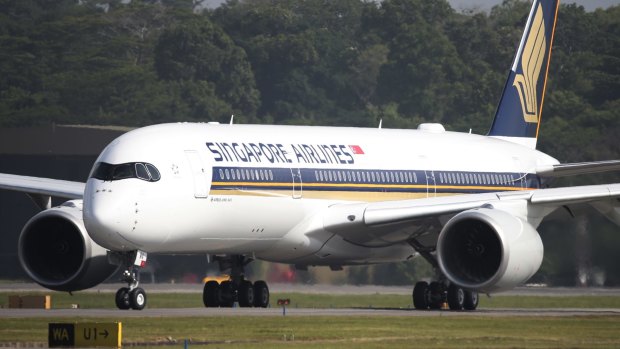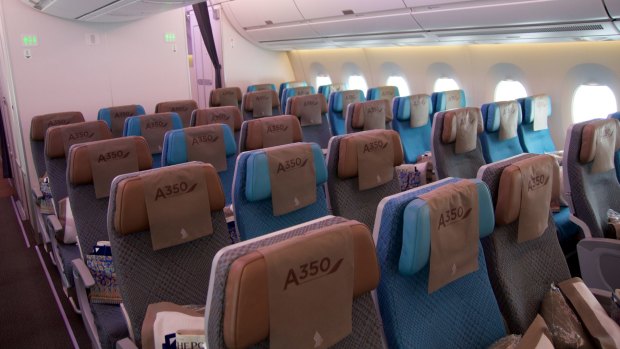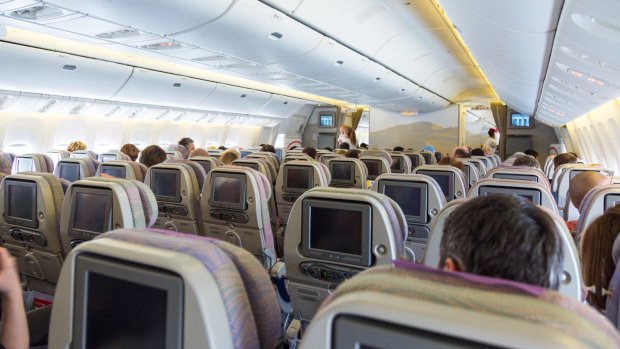This was published 4 years ago
Airbus A350 and Boeing 787 Dreamliner: Economy class seat width shrinks
By Graeme Waters

New aircraft like the Airbus A350-900 have benefits, but there are downsides.Credit: AP
I should have been more excited than I was when Singapore Airlines announced that it was introducing its newest aircraft, the Airbus A350-900, on to the Wellington (where I'm based) route last November. But having already experienced travel on the A350, and on the rival Boeing 787 Dreamliner, I was instead moved to shed a tear for the recently departed. In this case, it was for the Boeing 777-200 that the airline previously flew on the Wellington route.
Why the tear? To be frank, the business class section of Singapore's old B777 had started to look well past its use by date. No denying that all the AV technology and the smart new decor of the A350's business class is a better look. The new business class seats strike me as smart, comfortable and clever. And if premium economy strikes you as a bargain worth pursuing, the A350 has it all over their old B777, which simply did not have a premium economy section.
What SQ's old B777 did have in spades though was more elbow room in its economy section. This was an aircraft in which, configured in nine abreast, you could actually walk about the aisle without knocking every second passenger, and feel reasonably unsqueezed in your seat.

Nine across: Economy class on the Singapore Airlines A350-900.Credit: Getty Images
While 32 inches (82 centimetres) of legroom isn't generous, for a six footer like me it's not mean either. A long distance trip in that "old" B777 was always manageable. And the cabin layout had the supreme virtue of having the odd bit of spare space where a passenger could, dare we say it, "stand up and stretch their legs".
FEEL THE WIDTH
What made such luxury possible? Fundamentally, the B777 was designed with a generous girth. Its fuselage interior was just nine inches (23 centimetres) narrower than the 20-foot (six metres) width of the old B-747 jumbo jet. In its later years the B747 was typically fitted out in a 3-4-3 economy 10 abreast formation. On the B777, however, the default setting was 3-3-3, nine abreast. It meant, in effect, an extra inch of seat width for each economy passenger.

Most airlines flying the Boeing 777 now have 10 seats per row.Credit: iStock
Whoopee, but of course nothing is fixed in the aviation firmament. That setting of nine abreast was not adhered to by all carriers. From the beginning Thai Airways made the calculation that it could squeeze 10 seats abreast on its regional flights, reducing that extra inch of seat width to a negative sum. Just how negative depends on the precise mix of seat, armrest and aisle width, but suffice to say I and many others find the net result ghastly.
Sadly for the brand, Air New Zealand made a switch from nine abreast to 10 abreast when it refurbished its B-777 200 fleet a few years back. Fine for a family with two small kids, but the sight of four above average sized people thrust together in this configuration is not one for sore eyes. Nor is the sight of a food trolley being manouevred down such a narrow aisle. But hey, they train for this.
As it happens, the B777 in 10 abreast is about the tightest long haul squeeze currently on offer from the full service carriers. Air New Zealand's codeshare partner, Singapore Airlines, has resisted any temptation to resort to 10 abreast on its B777 fleet, making it a no brainer if you have to choose between the two. In fact, as they share revenue in a "common metal" arrangement, it's not even unpatriotic.
HOW WIDE IS 'EXTRA WIDE'?
But what has this got to do with the A350 and its Boeing rival, the B787 Dreamliner? Well quite a bit actually. The Dreamliner has a cabin width of exactly 18 feet (5.5 metres), which just happens to be 15 inches (38 centimetres) narrower than the B-777.
If you install seating in a 2-4-2 eight abreast layout, then your economy class passengers are even better off than on a B777 in nine abreast. But virtually every carrier has now plumped for nine abreast, making the Dreamliner almost as tight a squeeze as the B777 in 10 abreast – my bugbear remember. Even so, you are marginally better off in the Dreamliner.
If the same sized seats were used on both, each of the Dreamliner's twin aisles would be about two inches (5 cm) wider. But overall that amount of seat space is not much better than that of a single aisle Boeing 737 – which, incidentally, suffers from being seven inches narrower than its Airbus rival, the A320 series. It's a recurring theme of Airbus marketing that an 18 inch wide seat beats a 17 inch wide one.
Enter into this debate the new Airbus A350. The airline industry was ever so slightly nervous about the space available on a Dreamliner. British Airways, for example, had to install wider economy seats on its Dreamliners after complaints from passengers.
Airbus received lots of hints that it should aim to build something wider than the Dreamliner. So it did. Five inches wider, to be precise – just enough for it to warrant the label XWB – for Extra Wide Body – on its title. XWB or not, though, the A350 is still no size match for the old B-777 in nine abreast. It's still 10 inches (25 cm) narrower.
And being modern, and all that comes with it, those nice interior designers have ways of eliminating anything that looks like dead space where you can commit the ultimate sin of standing up (and worse, reading a book with it). On the one narrow piece of corridor across the economy toilet block, where loitering might look half achievable, Singapore Airlines helpfully added a sign that tells you not to stand there.
Talk to the cabin crew on one of these Airbus or Boeing carbon fibre miracle machines (and yes, it will have better AV, better air conditioning, pressurisation and mood lighting) and they will confirm the obvious too. If the aisle is narrower, and the people are more squeezed, then it's harder to serve everyone without banging into them. They, of course, are trained not to bang into you (your happiness is their happiness) but your fellow passengers aren't. So it happens.
What's the answer? Well, first thing to say is that if you want to reduce your carbon footprint, the more cramped the better. But if you find what's on offer in economy an intolerable squeeze, then your only recourse may be to upgrade to premium economy, at possibly twice the price, plus a good 50 per cent increase in carbon footprint.
Up front in business class it may be three times the price and more than double the carbon footprint. Having tried it all at different times, I know a bad bargain when I sit in one.
THE ALADDIN FACTOR
In the story of Aladdin, "new lamps for old" was the sly sales pitch to retrieve the magic lamp. It's a bit like that with aeroplanes. Two of the nicest economy class rides you'll experience are on the Airbus 380 double decker (in 10 abreast downstairs and eight abreast upstairs), and the Boeing 777 in nine abreast.
The A380 will cease manufacture next year, and ironically, one way to have kept it going might have been to convert the economy cabin layout to a 3-5-3 formation of 11 abreast. Mercifully that idea never flew. The Boeing 777 is about to be eclipsed by the Boeing 777-X, a newer derivative that critically manages to sculpt an extra four inches of cabin width out of the fuselage. That effectively makes 10 abreast the default setting in economy, much on a par with a Dreamliner in nine abreast when it comes to seat and aisle width. I'm sure you can't wait!
Let's face it, the operating economics will be fabulous and fares may stay lower for longer and maybe you'll even get to brag about reducing your carbon footprint a bit.
As for me, I'll keep looking out for an old B-777 in nine abreast or an old A380 in 10 abreast. And lest it be thought I'm a hopeless scrooge who won't fork out for premium economy, yes I'll happily pay a few dollars more for an extra inch or two of legroom when it's on offer in economy class.
Those extra inches don't always come cheap, but Virgin Australia's Economy-X is one example of the genre with a few extra perks priced in. Call it Methodist or Presbyterian business class if you must, or call me an old fashioned greenie, but maybe this is what a modest, carbon conscious business future could look like?
A DUCKWORTH LEWIS GUIDE TO AIRCRAFT SEATING
In one day cricket, the Duckworth Lewis system is designed to come up with a moral equivalent – the exact number of runs your team would need to beat your opponent's score if (because of rain delay) you had less time and overs in which to do it. Is there an equivalent system to estimate seat comfort on an aeroplane?
You can get some idea of how cosy (or not) a seat is going to be by going to TripAdvisor's "SeatGuru" website. This publishes both the seat pitch (ie the distance between each row of seats, and thus a clue to leg room - 32 inches is definitely preferable to 30 inches) and seat width of each class of seating in every plane of the major airlines.
It also has a layout map for each aircraft type and advises both good seat locations (eg with extra legroom or side space) and bad ones (eg next to a toilet). Their seat width figure on its own, however, is not a complete guide as it just gives the distance between the armrests. It doesn't tell you if armrest width has been reduced or the aisle made narrower.
Thus on the face of it a Boeing 777 in nine abreast may show a seat width of 17.8 inches (45.2 cm), and one in 10 abreast may show a seat width of 17.3 inches (43.9 cm). Do your own maths. Are you really only half an inch worse off? How much have they lopped off each armrest, and each aisle, to make this possible? And do you really want to experience the result if it's a full flight?
If we had a Duckworth Lewis system for airlines seats and classes, you could have an ascending order of merit, assuming similar legroom, to help you decide how much to pay for your ticket. At the top of the tree in economy class might be:
1. Airbus A380 in 10 abreast followed by
2. Boeing B777 in nine abreast
3. A350 in nine abreast
4. B787 in nine abreast
5. B777 in 10 abreast
Omitted from this listing are of course the "old" Airbus A330 and A340 series aircraft, which with their 17 feet (5.2 metres) cabin width are normally fitted out 2-4-2 in economy. In this eight abreast configuration, a window pair of seats is a good bet for a travelling couple and arguably more comfortable than an A350 economy triple or an old B747.
WHAT IF YOU'RE AT THE POINTY END?
In premium economy, the equation shifts a wee bit in favour of the Dreamliner – certainly in our part of the world. The Air NZ and Qantas seven abreast offering in a B787 beats the eight abreast on offer in the premium economy section of a Singapore Airlines A350. But eight abreast in the 21ft (6.4m) plus cabin of a Singapore A380 is very hard to beat in the premium economy stakes. Seat pitch by the way is typically 38 to 41 inches in premium economy – not enough to lie flat in but enough to stretch out a bit.
And what of business class? Well, no need to fret about a missing inch or two of legroom. If it's a new aircraft it'll be flash and generously proportioned in a lie flat way and the perfect use of someone else's money - which it often is.
Ditto for first class, really, should you ever indulge yourself or be selected. A higher level of deference may be your fate, but if you really want to show your class in first class, ask not to be disturbed and refuse all food and drink. You're only in it for the privacy and the night's sleep, right? Yeah right.
Graeme Waters is a former New Zealand diplomat whose flying experience includes being a passenger in single engine aircraft in Papua New Guinea and accompanying an elephant on an RNZAF Hercules. He has flown both business and economy class on recent duty with Stuff Travel and Wendy Wu Tours in India.
Sign up for the Traveller newsletter
The latest travel news, tips and inspiration delivered to your inbox. Sign up now.